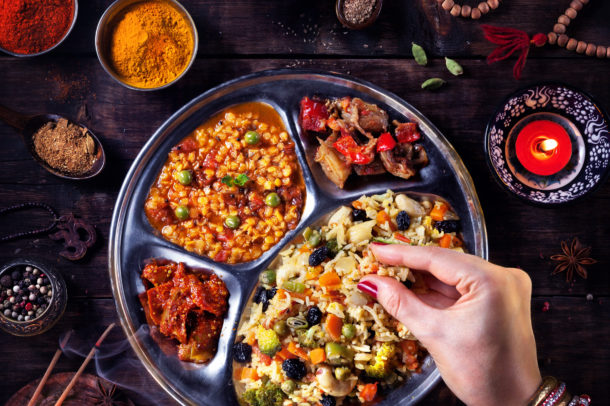Submitted by Gurpreet Virk, RD CDE
India is a diverse country with the world’s second largest population. It has 29 states and seven union territories. Each region has its own traditions, religion and culture that influence local cuisine. In general, India’s staple foods include pearl millet, rice, whole wheat flour and a variety of dried beans and lentils. Lentils may be used whole or dehusked. For example, dehusked and split black chana (Bengal grams) also known as washed or dehusked chana “daal”.
North Indian Cuisine
North Indian cuisine, also known as “Punjabi food”, is most popular in the country’s restaurants and synonymous with Indian food worldwide. This cuisine is a mix of simple to very rich and elegant vegetarian and meat dishes. A basic vegetarian meal may consist of a “daal” (lentils) and/or a “sabzi” (blend of one to two vegetables cooked with sautéed onion, garlic, ginger, and tomatoes), along with a side of plain yogurt served with thinly rolled whole wheat “chapati” or “roti” (flatbread).
Wheat flour, basmati rice, different types of lentils, and a variety of beans such as chickpeas, kidney beans and black-eyed beans are the staples of this region. A wide range of leafy greens and other vegetables are also eaten at every meal, while milk, butter, and ghee (clarified butter) are used exclusively for cooking and garnishing food.
North Indian food is often described as rich because of the plentiful use of milk, cream, butter, ghee, and nuts. “Garam masala” – a blend of different spices such as coriander powder, cumin, cloves, cinnamon, black cardamom, and black peppercorn – is also commonly used in North Indian cuisine.
A “sabzi” is an entrée prepared with one or more vegetables sautéed in ginger, garlic, and onions, along with crushed or puréed fresh tomatoes. Most “sabzis” are cooked with potato, which can make them high in potassium. “Daal” is one of the main dishes of a meal. Most of the time, more than one type of lentil is used, which enhances the nutritional profile of the dish. Thinly rolled whole wheat roti and/or rice serves as the main starch of the meal.
Foods such as stuffed paratha (lightly fried roti made with potato filling), “saag” (a blend of mustard leaves, spinach, fenugreek leaves), “chana” (chickpea curry), “bhatura” (fried sourdough bread), “samosas” (baked pastry with savoury filling), and “pakoras” (spiced fritters) etc., are high in potassium and sodium.
South Indian Cuisine
Rice is a staple of the South Indian diet and incorporated with lentils in a variety of dishes. Due to the proximity to the ocean, fish is an integral part of coastal South Indian meals. One of the salient features of this cuisine is “fermentation”, which gives food a distinct aroma and flavour. Rice and lentils are fermented to make dishes such as “dosa” (thin pancake or crepe) and “idli” (savoury rice cake).
Leafy green and starchy vegetables are generally stir-fried or roasted and added to curries. Fried plantain chips are a common snack in this region, but high in potassium. Coconut is used in cooking and to garnish food. Recipes often call for shredded coconut, coconut milk and coconut oil. The coconut water and the coconut ‘meat’ are also refreshing snacks. Coconut chutney is a popular accompaniment to almost all South Indian dishes. Since fresh coconut, coconut milk, coconut water, and coconut ‘meat’ are rich in potassium, they are incompatible with a low-potassium, kidney-friendly diet. However, dried shredded coconut may be added in small quantities of one to two tablespoons.
Water is usually served with meals. Tea is the beverage of choice in North India, while coffee is the preferred beverage in South India. Tea is typically prepared by boiling tea leaves in water with milk and sugar. Green cardamon, cinnamon or ginger are used as flavour enhancers. Green tea is also consumed in India.
Despite several similarities, North and South Indian cuisines remain distinct in appearance and taste. From a nutrition perspective, both are primarily plant-based with plenty of whole grains, beans, lentils, leafy greens, and other vegetables that are high in complex carbohydrates, fibre, protein, vitamins, and minerals, such as potassium and phosphorus. From a kidney diet standpoint, beans and lentils can be safely incorporated in meals by altering their potassium content. However, they must first be soaked in water and then boiled, which allows much of the potassium to leach into the water that is then discarded. Studies show that phosphorus from beans and lentils is poorly absorbed, therefore they are not considered a high source of the mineral. See our post, Reducing the Potassium in Legumes, for more information.
The primary sources of sodium in North and South Indian cuisines are table salt, salty snacks, chutneys, and “achars” (pickles). Pickles made with vinegar instead of oil can be less salty and safely incorporated in kidney diets. Processed meats and cheeses are not part of an Indian diet.
The overall fat content of some traditional dishes may be high because of the excessive use of milk, butter, cream, and ghee; however, it can be easily modified by using low-fat dairy products and by replacing butter and ghee with smaller amounts of unsaturated fat. Since people with kidney disease have specific dietary needs, working with a renal dietitian can help them choose the most nutritious dishes of North and South Indian cuisine to enjoy at mealtime.
